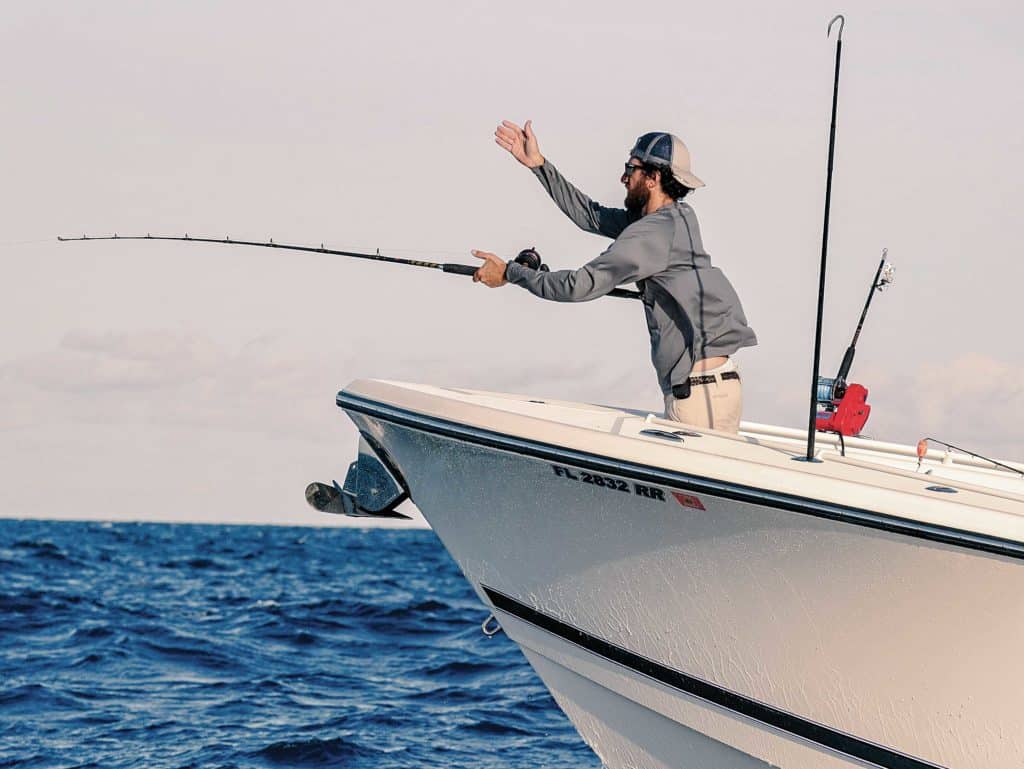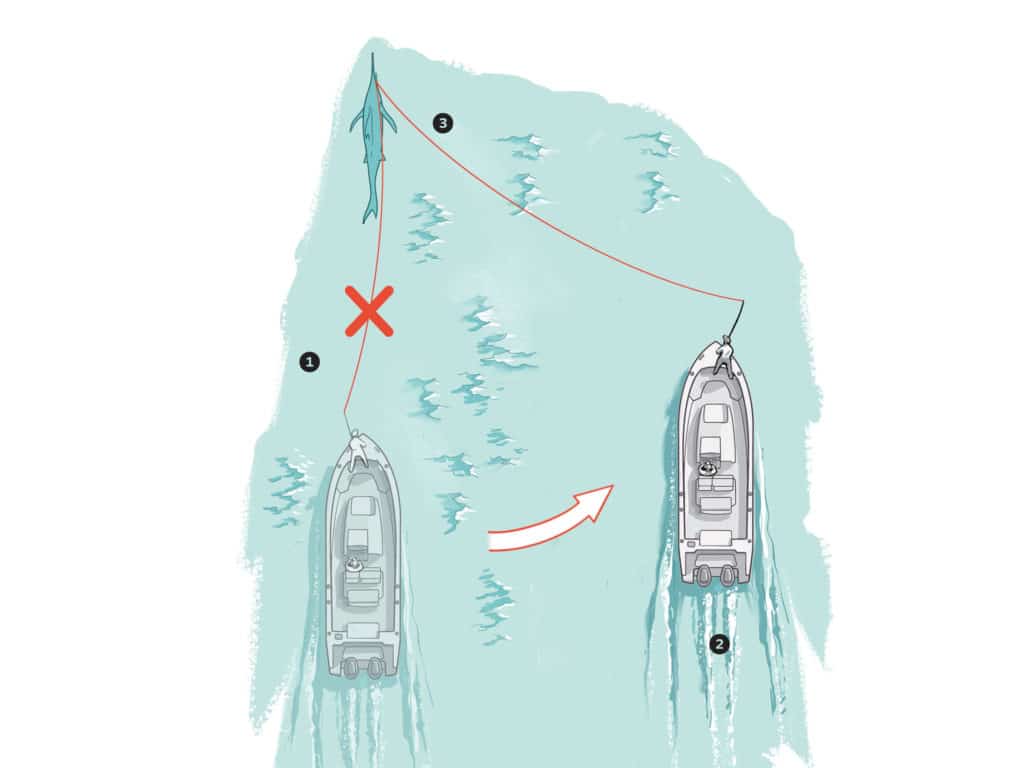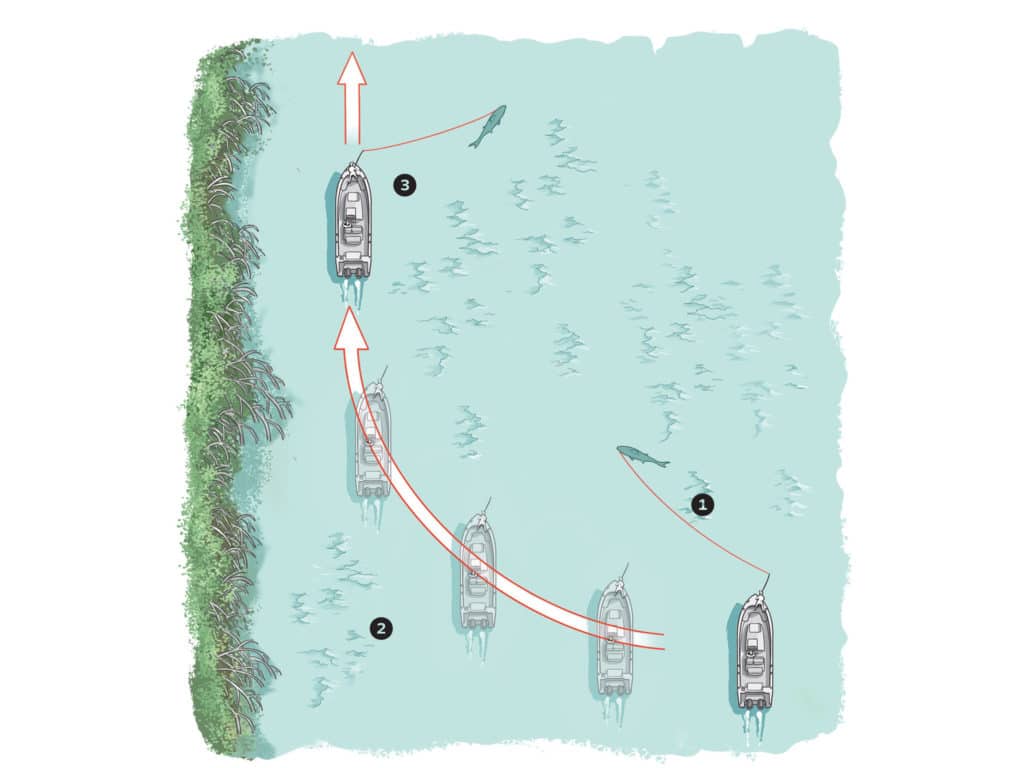
Chasing a hard-charging trophy fish involves foresight based on the nature of the species, its environment, and the tackle and line class. Simply watching a fish empty line from a reel, or hoping to avoid the inevitable by tightening the drag, is an angling mistake of the unforgivable kind.
Stunt Driving
Chasing down a long-running fish prevents it from stripping a reel, obviously. The accompanying reduction in drag pressure also keeps the line from parting and the hook from straightening or ripping free. But other factors must be considered as well.
The decreasing diameter of the line on a reel spool as the fish peels it off results in an increase in drag. Combine that with the resistance created by the line being pulled through the water, and a break-off is imminent unless quick action is taken, i.e., loosening the drag and giving chase.
But Wait!
Flotsam, the likes of thick sargassum concentrations, becomes a viable threat offshore. The more line paying into the water, the greater the risk of it contacting or collecting weeds, which also increases stress on the line. Keeping close to a running fish in weed-rich waters allows you to steer the fishing line around these threats.
When to Give Chase
Such a call hinges on the species and tackle. For offshore pelagics, I seriously consider giving chase around the quarter-spool mark, providing a fish shows no signs of slowing, and sooner with lighter line and challenging conditions like rough seas and thick weeds.
A perfect example of this occurred in May as we fought a sailfish on 20-pound tackle. With no signs of slowing, the sail blazed through heavy sargassum concentrations, and the mono line embedded itself in two clumps so large that they anchored it in place.

With the sailfish greyhounding at a 90-degree angle to the line pinned by the weed clumps, Abie Raymond reduced the drag. He successfully shook off one clump and removed the other with a gaff. The threat eliminated, he advanced the drag and quickly wound straight and tight to the fish. The fight had its moments of doubt but, with the quick response, we landed the fish.
These situations aren’t species exclusive. Corinne North Fuller hooked a beauty of a dolphin on 12-pound spin tackle on a slick ocean off Islamorada, in the Florida Keys. Her first offshore fish encounter was going brilliantly, until we came upon thick patches of weeds.
Given the size of this dolphin and the light line, I never let it get beyond a couple hundred feet from the boat. I closed the gap even more as we approached the weeds, encouraging Corinne to steer her line around any clumps. She did exactly that, and we soon boated the 36-pounder.
More recently, the same tactic helped Carl Grassi weed through challenging conditions to boat a 45-pound dolphin off Miami.
During both large dolphin encounters, going on the offensive and staying close to the fish paid off.
Chasing Pelagics
Keeping close to a fish is a good thing. Yet constantly running up on it can prolong a fight because it allows the fish to rest. It’s a fine balance between remaining close for control and line preservation, and letting the fish tire itself.
In clean water, let the fish run off 50 to 100 yards, then follow it with just enough momentum to keep a deep bend in the rod while the angler gains line under pressure. Once the gap closes to 50 to 100 feet, shift into neutral and let the fish run off more line before repeating the maneuver.
If possible, pursue a fish from the side it’s hooked on for a straighter pull, the ability to steer it when it tires, and to prevent the line from dragging across its body or tail-wrapping.
Communication between angler and helmsman is crucial; I want to know roughly how far off the fish is, its heading, and if the angler is successfully gaining line. Once the chase nears the end, I’ll ease ahead of the fish for the landing and releasing duties.
Chasing Bottom Dwellers
Successful bottom anglers also know the importance of giving chase. If reef fishing adjacent to a pronounced ledge or contour drop, a large bottomfish, like an amberjack, African pompano or even a cobia, might run straight off that ledge. From a stationary boat, the line will surely drag along that edge and part.
When an unstoppable fish charges off like that, the boat should follow. The goal: Keep the line as vertical as possible to keep it out of danger.
It’s a bit different when power-drifting for big bottomfish on wrecks. After hooking up, the helmsman should help the angler muscle the fish from the hulk by powering the boat away from it.
Inshore Too
Follow some of these bottom guidelines for large inshore species like cobia, tarpon, snook and permit, which often feed along pronounced ledges, channels and inlets.

Chasing might also prevent a fish from charging into bridges, docks, shoreline structures and even other boats. The trick here is to get between the fish and the threatening structure forcing the fish to run in the opposite direction and away from obstacles.
Anchors and Big Fish
Pelagics such as cobia, king mackerel, permit, sailfish, and even wahoo and tuna often show up behind boats anchored over a wreck or structure. To succeed at catching them on light tackle, a quick chase is a prerequisite.
Many boats sport windlass anchors that cannot be retrieved quickly enough to give chase. I carry an old-school anchor with two 150-foot clip-on sections of rode for bottomfishing.
Read Next: What is Side Pressure?
I clip the bitter end to a poly ball. Should a fish require chasing, we uncleat the rode, toss it overboard, and give chase—no time lost. After the fight, we simply run back to our spot, retrieve the poly ball, and recleat the rode. To recleat precisely, a wrap of bright tape on the rode will ID the mark.
Chase Must-Dos
1. Reduce drag slightly as the spool diameter decreases during a blistering run.
2. Maintain a straight line to the fish, preferably on a slight angle, to keep the line from fouling.
3. When in pursuit, always retrieve line under adequate pressure to stay tight to the fish.
4. As the boat closes in on the fish, gradually advance the drag to its fighting setting; until then, gain additional drag with your hands.









